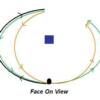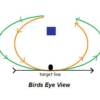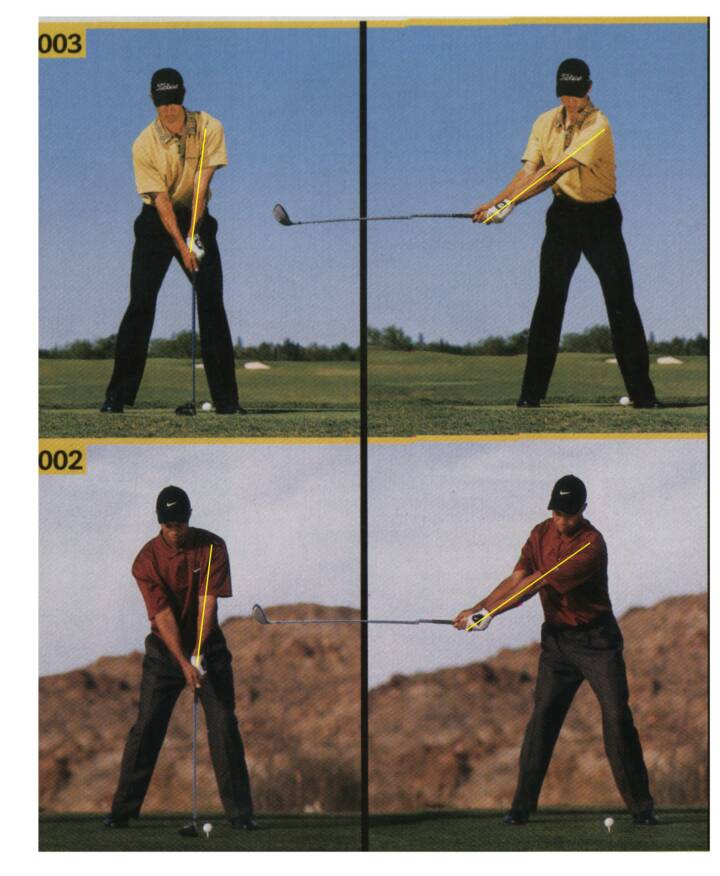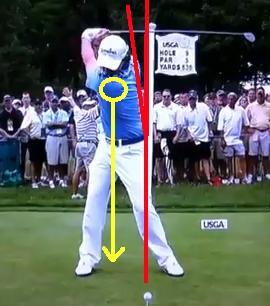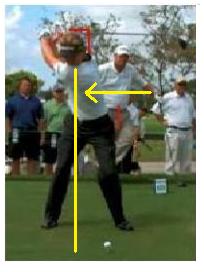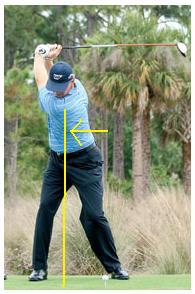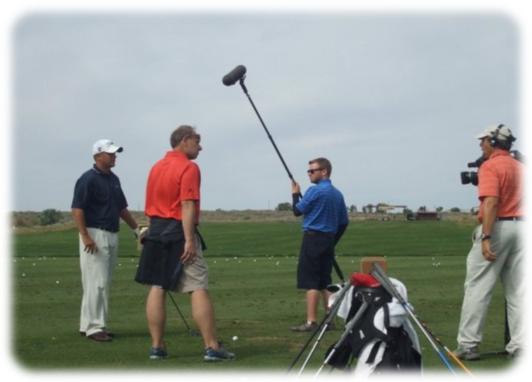Back Swing Arc
Click on the diagram to the right above. This diagram is the basis for the 'On Plane' swing. During the 'On Plane' swing, the forward swing 'circle' and the backswing 'circle' (or arc if you will) are very close in size and shape (almost identical). Why? Simplicity. I've stated before... if we can remove all the unwanted, extra, compensating movements during the golf swing there is a VERY good chance we will develop a swing that repeats and is efficient. With all due respect.... for every Jim Furyk (although, his swing has been refined tremendously since his rookie days), there are 1000's of everyday people trying to break 100 with a motion similar or as unorthodox as Jim Furyk's motion. Jim Furyk does get the club on a exceptionally good 'tour' arc/circle on the forward swing (but he does take the scenic route to get there). This requires timing, practice, and god given hand/eye coordination. Jim Hardy believes that Furyk is the best example of his 'One Plane' model. That caught me by suprise when I attended Jim Hardy's seminar in Rochester at Oak Hill CC.
EFFORTLESS POWER
A straight left arm with a full shoulder turn is MUCH more efficient (effortless power) than a soft (bent) left arm with less than full shoulder turn at the finish of the back swing arc (powerless effort). Look at the these pics. You'll notice 3 EXTREMELY important elements of a very efficient back swing arc:
- firm/straight left arm
- full shoulder turn (although his backswing length is short of parallel... he has a complete full turn)
- dynamic transfer of weight to the rear foot (moved off the ball maybe 3 to 5 inches with driver, less with shorter clubs)
Early Wrist Set: Why an early wrist set versus a 'one piece' takeaway? The swings of yesteryear have long promoted and adopted a 'one piece takeaway' (shoulders, arms, and hands start the takeaway simultaneously). I believe strongly in an early wrist set. This early wrist set is a must (I will explain why later). A good drill to perform to achieve this position is to incorporate the ‘big’ waggle during the pre shot routine (very much like Hogan used to do). This waggle involves only a ‘hinging’ of the wrists to begin the backswing. The shoulders for all intents and purposes almost remain stationary during this waggle. When performing the pre shot routine ‘waggle’, the golfer must hinge the wrists such that the golf club shaft reaches a point ‘parallel’ to the ground and simultaneously ‘parallel’ to the target line. When this is performed properly 3 things will occur: the club shaft will be parallel to the ground, the club shaft will be parallel to the target line, and the ‘toe’ of the club will be pointing directly towards the sky (this will require a pronation of the wrists).
Backswing Arc: Think wide! The wider, the better. The left arm (right hand golfer) is extended fully and does not break/bend. Keep it straight/firm. The left arm will remain straight/firm until the golf ball has left the club face on the forward swing. DO NOT sacrifice left arm firmness during the backswing for back swing length (ie: bend the left arm for a longer backswing). A long back swing via a 'soft left arm' will not increase club head speed. It will encourage powerless effort (extra inefficient movement that does not contribute to club head speed and efficiency). The inefficient and elongated backswing arc (created by the soft left arm or excessive wrist hinge) will almost inevitably encourage many unwanted problems: reverse weight transfer, narrow downswing arc, etc. The firmness of the left arm is EXTREMELY important for clubhead speed to be maximzied and to help encourage the dynamic transfer of weight to the rear foot during the back swing (effortless power). The wide back swing arc will also serve as 'blueprint' if you will for the forward swing arc.
Now, why an early wrist set? This is best answered by explaining the negatives of a late wrist set or a ‘one piece takeaway’, ala the swings of yesteryear. When a golfer incorporates a one piece takeaway during the backswing, then he will inevitably set the wrists close to or into the transition area of the backswing (the transition between the backswing and forward swing). This 'late wrist set' will encourage a very late ‘release’ in the downswing. Although the club head speed gained by this is extremely enviable, the negatives outweigh the positives. For instance, the hands will be too far ahead of the golf club at impact which delofts the club head during impact and points the clubface right of target (for right hand golfers). In order to compensate for this the golfer must ‘spin’ the hips’ and ‘flip’ the wrists to the square the club face at impact. Now, unless you have extremely good hand/eye coordination and perfect timing you will not be able to compensate for this during the downswing.
David Leadbetter worked on the early wrist set extensively with Nick Faldo. It helped him become the best player in the game for many years. Now, you are seeing a host of touring professionals incorporate this into their golf swing: Chris Dimarco, Tiger Woods, Hank Keuhne, and Mike Weir to name a few. Secondly, an early wrist set is natural! Your hands are attached to your arms by hinges (wrists) so let them hinge! Let me explain this by an example. Pick up a hammer and drive a nail into a piece of wood. What happens??? Immediately, as you raise your arm your wrist sets. It is very UNNATURAL to hammer a nail into the piece wood with a late wrist set or worse yet… no wrist set (sorry, Mr. Moe Normon, Natural Golf is very unnatural).
EARLY WRIST SET
Shoulders remain stationary, forearms pronate open and the wrists hinge until this is achieved:
- Club shaft is paralellel to ground
- Club Shaft is paralellel to target line
- Club face is in 'toe up' position
(double click to expand video)
Ernie Els
Luke Donald
Rory McIlroy
